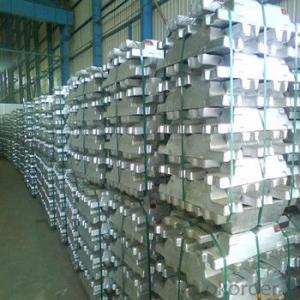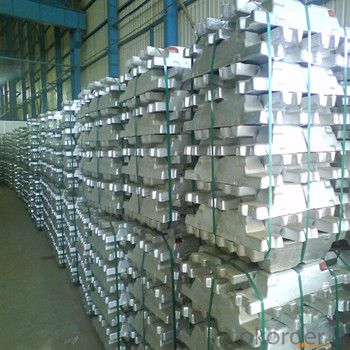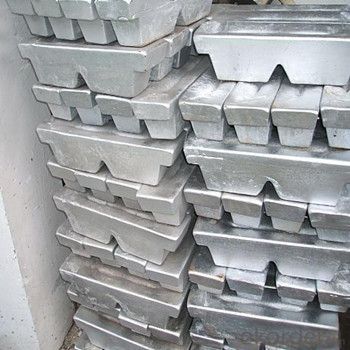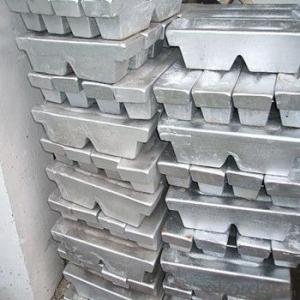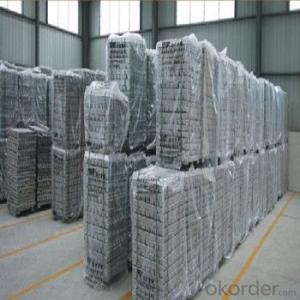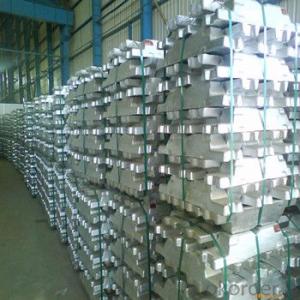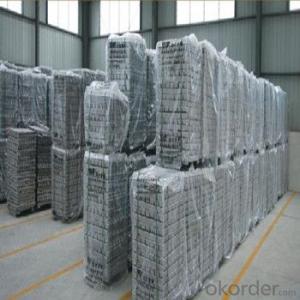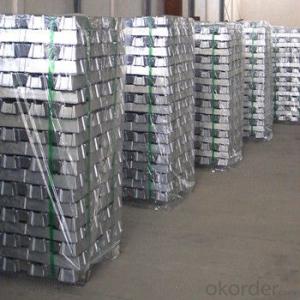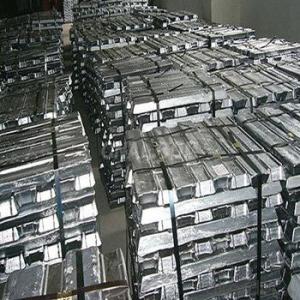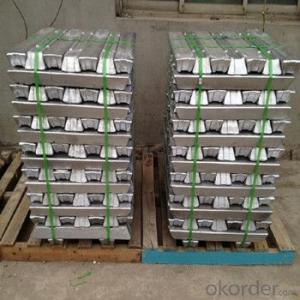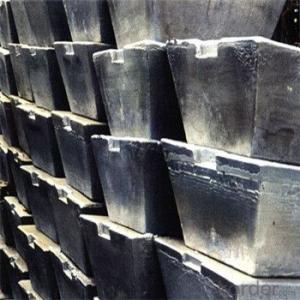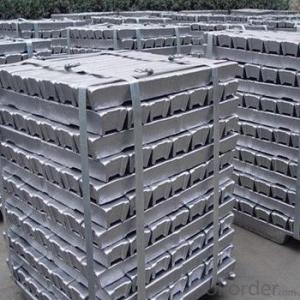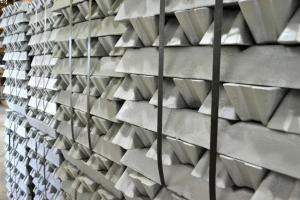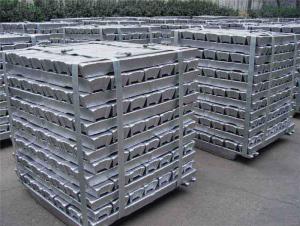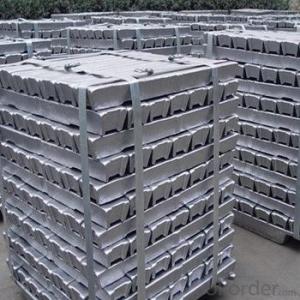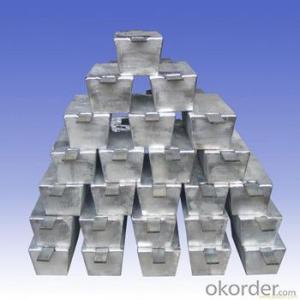Aluminium Ingot with Good Price and Hot Sale for the Markets
- Loading Port:
- China main port
- Payment Terms:
- TT or LC
- Min Order Qty:
- 1000 m.t.
- Supply Capability:
- 10000 m.t./month
OKorder Service Pledge
OKorder Financial Service
You Might Also Like
Pure Aluminum Ingot Used for Industry
1.Structure of Aluminum Ingot Description
Aluminum Ingot is with the AL as the main chemical composition. Aluminum Ingot is used for industry,such as automobile,pinning and weaving,electron broadly and so on. Aluminum Ingot has the following advantages: easy control and operation, fast melting.
2.Main Features of the Aluminum Ingot
•High Purity
•Easy control and operation
•High strength
•Fast melting
•Competitive price
•Best Service
3. Aluminum Ingot Images
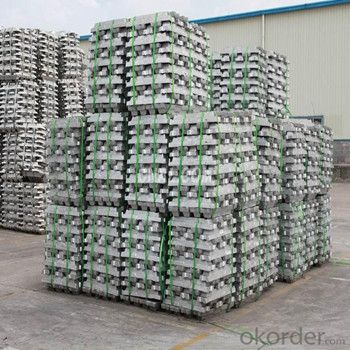
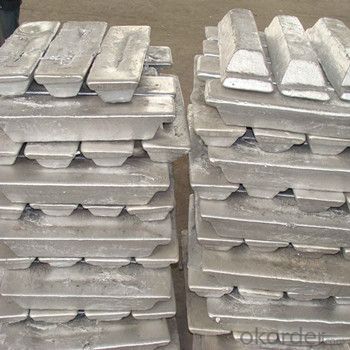
4. Aluminum Ingot Specification
Grade | Chemical Composition % | |||||||||
Al≥ | impurities ≤ | |||||||||
Si | Fe | Cu | Ga | Mg | Zn | Mn | others | Sum | ||
Al99.9 | 99.90 | 0.50 | 0.07 | 0.005 | 0.02 | 0.01 | 0.025 | - | 0.010 | 0.10 |
Al99.85 | 99.85 | 0.80 | 0.12 | 0.005 | 0.03 | 0.02 | 0.030 | - | 0.015 | 0.15 |
Al99.7 | 99.70 | 0.10 | 0.20 | 0.010 | 0.03 | 0.02 | 0.030 | - | 0.030 | 0.30 |
Al99.6 | 99.60 | 0.16 | 0.25 | 0.010 | 0.03 | 0.03 | 0.030 | - | 0.030 | 0.40 |
Al99.5 | 99.50 | 0.22 | 0.30 | 0.020 | 0.03 | 0.05 | 0.050 | - | 0.030 | 0.50 |
Al99.00 | 99.00 | 0.42 | 0.50 | 0.020 | 0.03 | 0.05 | 0.050 | - | 0.050 | 1.00 |
5.FAQ of Aluminum Ingot
We have organized several common questions for our clients,may help you sincerely:
①How about your company?
A world class manufacturer & supplier of castings forging in carbon steel and alloy steel,is one of the large-scale professional investment casting production bases in China,consisting of both casting foundry forging and machining factory. Annually more than 8000 tons Precision casting and forging parts are exported to markets in Europe,America and Japan. OEM casting and forging service available according to customer’s requirements.
②How to guarantee the quality of the products?
We have established the international advanced quality management system,every link from raw material to final product we have strict quality test;We resolutely put an end to unqualified products flowing into the market. At the same time, we will provide necessary follow-up service assurance.
③How long can we receive the product after purchase?
In the purchase of product within three working days, We will arrange the factory delivery as soon as possible. The pecific time of receiving is related to the state and position of customers.Commonly 7 to 10 working days can be served.
- Q: How are impurities removed from aluminum ingots during production?
- Impurities are eliminated from aluminum ingots in the production process through a refining process. The refining process typically consists of two primary steps: degassing and filtration. During degassing, the aluminum melt undergoes high temperatures and low pressures. This assists in the removal of volatile impurities, such as hydrogen, which can lead to porosity and brittleness in the end product. The high temperature and low pressure conditions permit the impurities to escape as gas bubbles, which are subsequently extracted from the melt. Filtration follows as the subsequent stage of impurity removal. The aluminum melt is passed through a filtration system containing ceramic filters or other porous materials. These filters are designed to trap solid impurities like oxides, non-metallic particles, and other foreign materials. The filters possess a specific pore size that exclusively allows the molten aluminum to pass through while retaining the impurities. This filtration process aids in enhancing the quality of the aluminum by reducing the levels of non-metallic inclusions, which can detrimentally impact the mechanical properties of the final product. It also contributes to regulating the grain structure and enhancing the overall homogeneity of the aluminum ingots. In conjunction with degassing and filtration, other refining techniques, such as fluxing and electromagnetic stirring, may also be implemented based on the specific requirements of the production process. Fluxing encompasses the addition of chemical compounds to the aluminum melt to facilitate impurity removal. Electromagnetic stirring employs electromagnetic fields to augment the mixing and distribution of the melt, thereby assisting in impurity elimination. Overall, impurities in aluminum ingots are effectively eliminated during production by combining degassing, filtration, fluxing, and electromagnetic stirring processes. These refining techniques guarantee that the final aluminum product adheres to the desired quality standards and exhibits optimal mechanical properties.
- Q: What is the weight of a standard aluminum ingot?
- The weight of a standard aluminum ingot can vary, but it is typically around 50 pounds (22.7 kilograms) or 25 kilograms.
- Q: Why milling through milling machine before rolling aluminium ingot?
- The aluminum ingot casting surface of casting defects, guaranteed after removal of the processing quality, and not easy to oxidation (or aluminum oxide layer is thin, dense, not deep) after removal can be hot or hot extrusion; some heavier oxidation materials must be hot or hot extrusion after milling, in order to ensure the surface quality of cold rolling
- Q: What are the environmental impacts of producing aluminum ingots?
- The environmental impacts associated with the production of aluminum ingots are diverse. One major concern revolves around the extraction of bauxite, the primary ore used in aluminum production. The mining process, which often involves deforestation and habitat destruction, leads to the loss of biodiversity and disrupts ecosystems. Refining bauxite into alumina, a precursor to aluminum, demands significant amounts of energy. Typically, this energy is sourced from non-renewable fuels like coal or natural gas, resulting in greenhouse gas emissions and contributing to climate change. Subsequently, electrolysis is employed to convert alumina into aluminum metal, necessitating substantial electricity consumption. If this electricity is generated from fossil fuel-based power plants, it further exacerbates greenhouse gas emissions. Nevertheless, some aluminum smelters are transitioning to renewable energy sources, which aids in reducing their carbon footprint. The production of aluminum ingots also generates waste and by-products. The residue left after extracting alumina, known as red mud, possesses high alkalinity. If not properly managed, this residue can pose risks to soil and water quality and harm aquatic life if it enters nearby water bodies. Moreover, the transportation of bauxite, alumina, and aluminum ingots over long distances contributes to carbon emissions and air pollution. The extraction and production processes may also require the utilization of chemicals and other resources, which, if not properly managed, can have negative impacts on local ecosystems and water sources. In conclusion, the production of aluminum ingots entails various environmental impacts, including deforestation, greenhouse gas emissions, waste generation, and potential water and soil pollution. However, the industry is actively striving to address these concerns through the adoption of renewable energy, improved waste management practices, and resource efficiency measures.
- Q: What are the different casting methods used for aluminum ingots?
- There are various casting methods commonly utilized in the production of aluminum ingots. These methods encompass: 1. Utilizing Permanent Mold Casting: This technique involves the use of an iron or steel permanent mold to shape the molten aluminum into ingots. The mold is preheated and coated with a release agent to prevent sticking. The molten metal is then poured into the mold, left to solidify, and subsequently, the mold is opened to extract the ingot. 2. Employing Continuous Casting: This method necessitates pouring the molten aluminum into a water-cooled mold that possesses a continuous cavity. As the metal solidifies, it is constantly drawn out of the mold, resulting in a continuous strand of aluminum ingots. This approach is frequently employed for the production of substantial quantities of ingots with consistent shapes. 3. Implementing Sand Casting: Sand casting is a widely employed technique for casting aluminum ingots. A sand pattern of the desired ingot shape is created, and then the mold is formed by packing sand around the pattern. The molten aluminum is poured into the mold and allowed to cool and solidify. Once solid, the sand mold is broken apart to reveal the ingot. 4. Utilizing Die Casting: Die casting is a method commonly used to produce small to medium-sized aluminum ingots with intricate details. In this process, a steel mold, known as a die, is employed. The molten aluminum is forced into the die at high pressure and rapidly cooled to solidify. The die is then opened, and the ingot is ejected. 5. Employing Centrifugal Casting: In this method, the molten aluminum is poured into a rotating mold. The centrifugal force causes the metal to spread out and solidify against the mold walls, resulting in a cylindrical ingot. This approach is particularly beneficial for manufacturing hollow or tubular ingots. Each casting method possesses its own set of advantages and disadvantages, and the selection of the method depends on factors such as the desired ingot shape, size, quantity, and specific application requirements.
- Q: 102 non-standard aluminum ingot is like? And ordinary non-standard aluminum ingot what is the difference?
- Nonstandard 102 is aluminium ingot produced by waste aluminium smelting, containing silicon between 8-12%, and remaining iron, zinc and copper content below 1Lower quality requirements for die casting aluminium ingots
- Q: Can aluminum ingots be anodized?
- Yes, aluminum ingots can be anodized. Anodizing is a process that involves creating an oxide layer on the surface of aluminum, which can be done on both raw aluminum and aluminum alloys. This process enhances the metal's corrosion resistance, improves its appearance, and allows for coloring or dyeing options.
- Q: Analysis of die casting aluminium ingot
- The commonly used classification, composition, die-casting aluminum ingot prices are as follows: the main element analysis table number grade classification (%) price (yuan / ton) Note: 9.6-12 1 ADC12 standard silicon, copper iron: 1.6,: 0.9,: 1,: 0.2 mg of zinc, lead as reference: 0.15
- Q: What are the main factors influencing the choice between aluminum ingots and aluminum forgings?
- Several factors need to be taken into account when deciding between aluminum ingots and aluminum forgings. 1. The complexity of the desired design is a crucial factor in determining which option to choose. If the design requires complex shapes or intricate designs, forgings are generally preferred. They have the ability to be shaped into specific forms with minimal internal defects, making them suitable in such cases. 2. The mechanical properties required for the end product also influence the choice. Forgings are known to have superior mechanical properties compared to ingots, such as higher strength, better fatigue resistance, and improved impact toughness. Therefore, if high mechanical performance is necessary, forgings might be the preferred option. 3. Material waste is another consideration. Aluminum ingots are typically machined from large quantities of material, generating a significant amount of waste. On the other hand, aluminum forgings are produced through a forging process that minimizes material waste. So, if waste reduction is a concern, forgings could be a more environmentally friendly choice. 4. Cost is an important factor to consider. Aluminum forgings often involve additional manufacturing steps, which can increase the overall cost. In contrast, aluminum ingots may require less processing, making them a more cost-effective option in some cases. 5. The required production volume also plays a role. Aluminum ingots are better suited for high-volume production due to their ability to be easily cast into various shapes. Aluminum forgings, on the other hand, are more commonly used for low to medium volume production, as the forging process is more time-consuming and costly for large-scale production. In conclusion, the choice between aluminum ingots and aluminum forgings is influenced by factors such as design complexity, mechanical properties, material waste, cost considerations, and production volume. Carefully considering these factors will help determine the most suitable option for a given application.
- Q: How can I make aluminium ingots for cans?
- You need a basic open hearth is heating aluminum cans, but is not the direct melting aluminum ingot what meaning, that thing in a lot of impurities, but also remove the magnesium, zinc, manganese and other elements, these processes need professional personnel, so difficult to master.
Send your message to us
Aluminium Ingot with Good Price and Hot Sale for the Markets
- Loading Port:
- China main port
- Payment Terms:
- TT or LC
- Min Order Qty:
- 1000 m.t.
- Supply Capability:
- 10000 m.t./month
OKorder Service Pledge
OKorder Financial Service
Similar products
Hot products
Hot Searches
